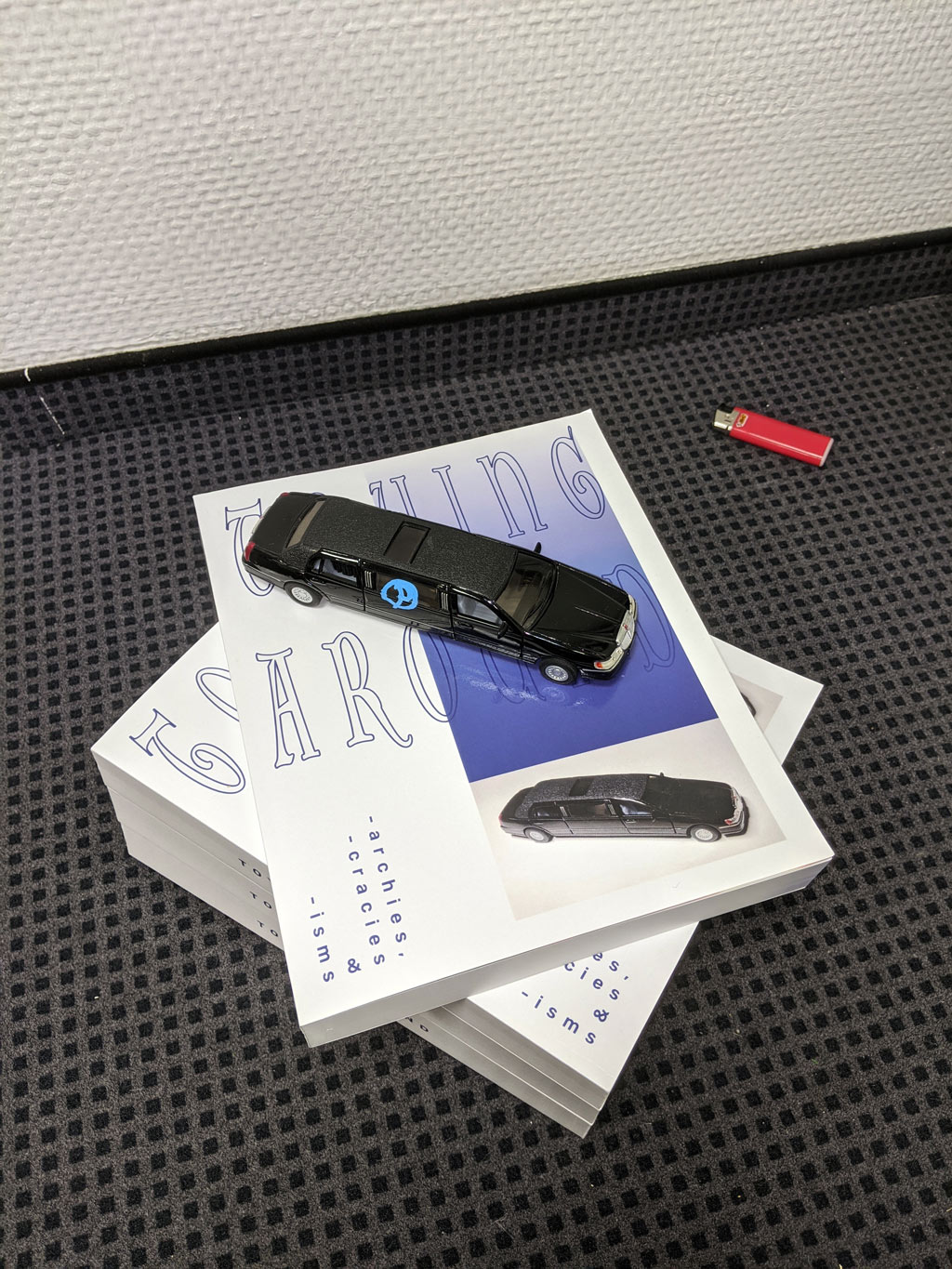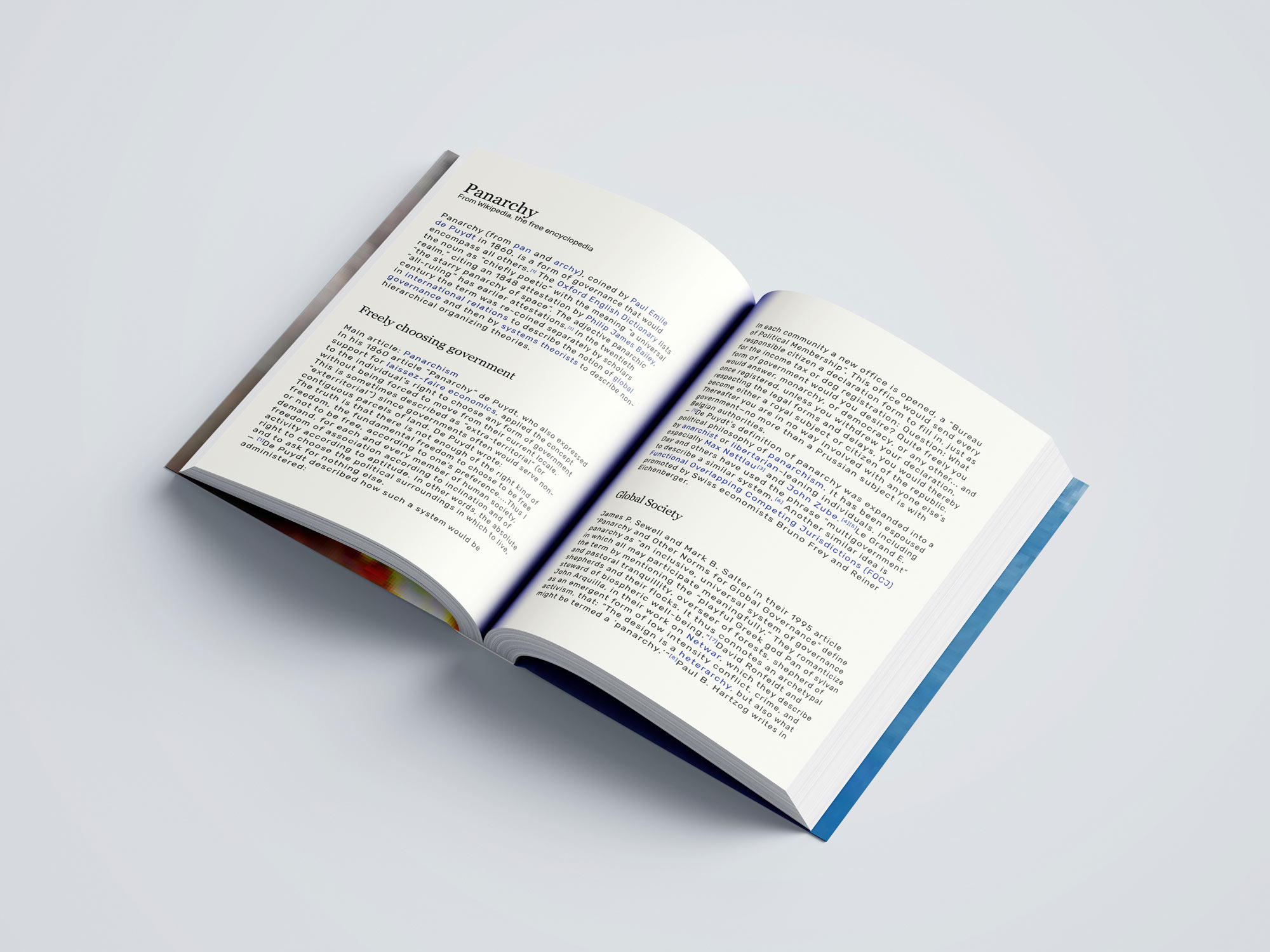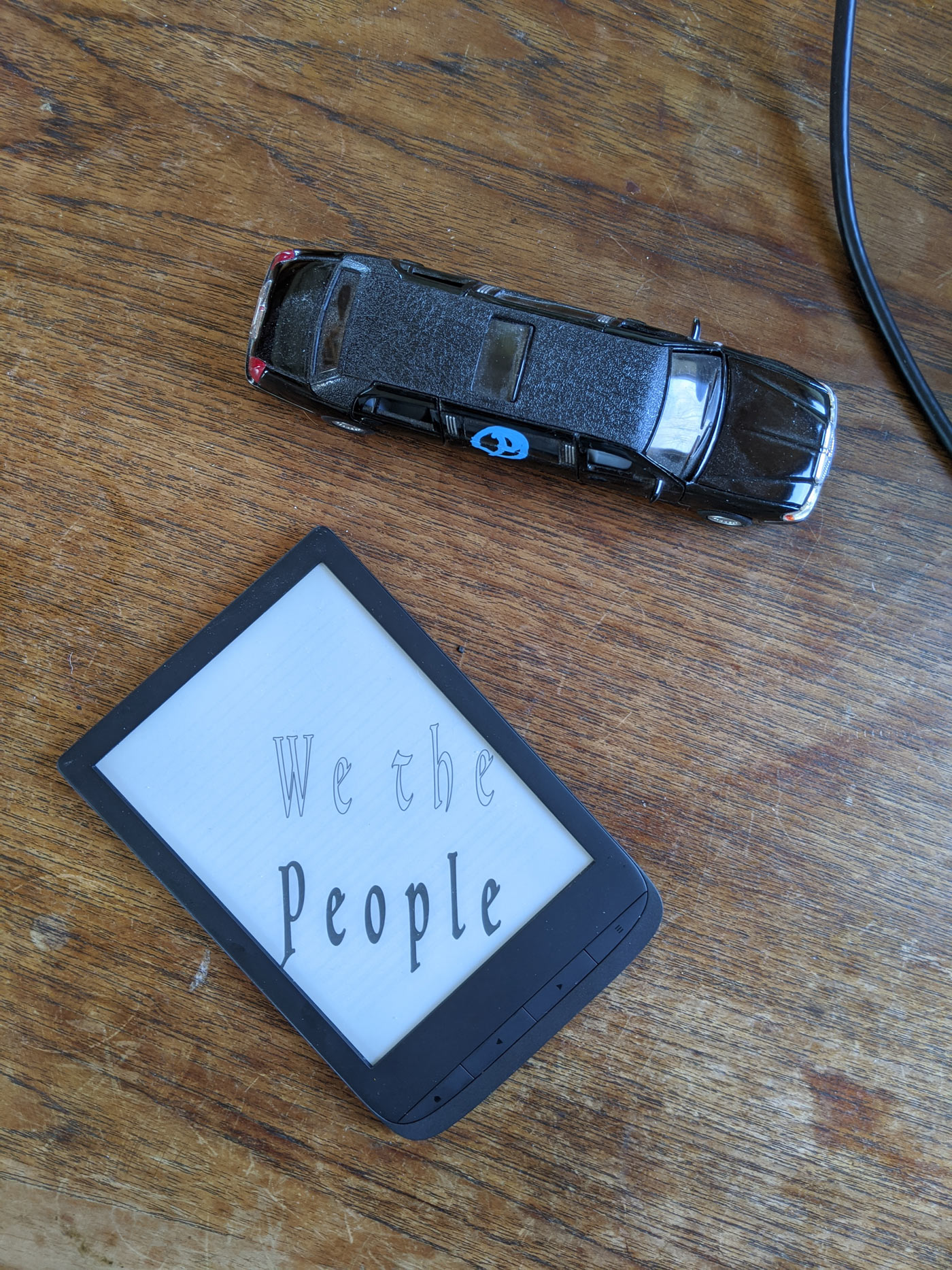
TOYING AROUND:
-ARCHIES,
-CRACIES
&
-ISMS
Ebook and Print-on-Demand Self-Publication
Henrik Nieratschker 2021
Is democracy failing us?
The artist publication Toying Around presents a short essay in interpretation of the press coverage of protests during the 2017 US presidential inauguration that poses this very question. In search of an answer, we encounter a collection of Wikipedia articles in the second half of the book, showcasing a wide variety of forms of government. From Matriarchy to Technocracy to Despotism, engaging with the theories and histories of these -archies, -cracies and -isms might help us to identify ways to move forward with democracies in crisis.

TOYING AROUND
-archies, -cracies & -isms
You might remember the photograph above.
During the protests surrounding the inauguration of the United States’ 45th president on January 14, 2017 in Washington D.C., a Lincoln stretch-limousine was spray-painted with a circled A and the phrase “We the People”. The election of Donald Trump, while certainly in line with a globally observable rise of populist, xenophobic, and reactionary politics, came as a shock to many US residents and caused a surge in left-wing political organisation and large-scale protests in the years after. Our ideologically marked limousine above was later set on fire using a burning, red signal flare, creating a powerful image that both left and right-leaning media outlets rushed to pick up and propagate.
We can look at this graffiti (and the following arson) as an act of vandalism inspired by a political belief system that opposes inequality and hierarchical structures of power. But, as with any graffiti, we can also look beyond the supposed vandalism and observe this visual composition as a piece of art, a social and cultural expression of the moment, and therefore an object that is interpretable and ready to be made into theory and applied to our understanding of the contemporary world.
This is what this short text (and in a wider sense the making of this book) sets out to do. As the political act of property damage ultimately missed its target (the owner of the limousine was neither an oligarch nor politician, but the founder of a car service, who, somewhat ironically, also happened to be a muslim immigrant1), one might find comfort in the thought that at least its powerful symbolism could provide a spark for thought, and that always means change in some way.
△ (Anarchy, Limousine, We the People)
Let’s begin by taking a look at the circled A. Popularised by punk rock acts like Crass and The Sex Pistols in the 1970s, the symbol is now firmly established in popular culture. You will likely know:
A stands for Anarchy.
While the use of the symbol by youth- and counterculture mostly derives from anarchism’s strong anti-authoritarian tendencies, signifying opposition to the hierarchical structures that shape contemporary society, the circle, or O, surrounding the A is of equal importance. In reference to ideas from Joseph Proudhon’s book What is Property, first published in 1840, the combined O and A of the logo invoke the phrase "Society seeks order in anarchy" (in French: La société cherche l'ordre dans l’anarchie).2
In contrast to this reading of the symbol, the idea of anarchy is usually painted as chaos inducing in mainstream cultural and political discourse, disregarding over 150 years of organized political work. Originating from the crest of the Federal Council of Spain of the International Worker’s Association, the Circle-A can be said to have been in use since the mid-1800s and from there has spread into youth culture of the 1960s.3 We could also discuss here the tumultuous history of anarchism and its role in modern and post-war era politics, its initial involvement in the first and second internationals, its continued global spread since the turn of the last century, and the many strands of anarchism that exist today, but we will leave it at this for now.4
One more thing though: Anarchism, as a practice, debatably pre-dates politics. In fact, anthropologists study the concept of non-hierarchical living in primitive hunter-gatherer and horticultural societies, with some arguing that “resistance to being dominated was a key factor driving the development of human consciousness, language, kinship and social organization”.5 Following this argument it could be claimed that credit for creating human civilization could be given to intuitively anarchistic tendencies within pre-historic societies. So let’s briefly wonder why it is then, that for most, the absence of some form of hierarchy immediately equals a state of chaos and the downfall of a civil society?
The questioning of hierarchy brings us to the second element of this symbolic triangle: The limousine. The stretched Lincoln Town Car that was parked on the sidelines of the inauguration protests had to stand in as a placeholder for notions of (economic) inequality and privilege. In fact, this use of the luxury car as a sort of synecdoche (for capitalism, the patriarchy, etc.), aligns quite nicely with the history of this particular type of vehicle.
When drafting the first designs of the automobile, which were directly derived from the horse-powered coaches of the time, car manufacturers copied the seating layout of luxury carriages that offered a separated, private compartment for the wealthy passengers, while the coachmen in front had to steer the vehicle sitting exposed to the outside. The coachmen and coachwomen were sometimes offered a degree of protection from rain through a hood extending over the driver’s seat of the coach. This is how the limousine first got its name, as these hoods resembled a particular kind of hood, seen on the clothing of shepherds in the french region Limousin.6
Today the driver of the limousine is protected from wind and weather, but they’re still separated from their more privileged passengers in the roomy back, with both parties only communicating via the installed intercom system. If lucky, our driver will get handed a stack of bills as a tip at the end of the ride. I will assume that one of these bills is a recently printed ten dollar bill, as this does not only provide our driver with a little extra income, but ourselves with a nice segway into the last corner of our triangle.
As our limousine driver folds the cash to put it into their pocket, they look at the right half of the obverse side of the bill, where, as Alexander Hamilton’s portrait disappears on the left, the phrase “We the People” remains in red ink.
(
I’m gonna go on a short detour here, as a discussion of the ten dollar bill is both fascinating and relevant to the wider context of this text. Think of this as a hyperlink, clicked on while reading a long Wikipedia article. If you read about gorillas you might as well learn about orangutang, right?
In fact, let me quote from the Wikipedia article7 of the ten dollar bill directly:
“
The $10 bill is unique in that it is the only denomination in circulation in which the portrait faces to the left.
In 2015, the Treasury Secretary announced that the obverse portrait of Hamilton would be replaced by the portrait of an as-yet-undecided woman, starting in 2020.[3] However, this decision was reversed in 2016 due to the surging popularity of Hamilton, a hit Broadway musical based on Hamilton's life.”
“On June 17, 2015, Treasury Secretary Jack Lew announced that a woman's portrait would be featured on a redesigned ten-dollar bill by 2020. The Department of Treasury was seeking the public's input on who should appear on the new bill during the design phase.[11]
Removal of Hamilton was controversial. Many believed that Hamilton, as the first Secretary of the Treasury, should remain on U.S. Currency in some form, all the while acknowledging that U.S. Currency was long overdue to feature a female historical figure – names that had been raised included Eleanor Roosevelt, Harriet Tubman, and Susan B. Anthony. This led to the Treasury Department stating that Hamilton would remain on the bill in some way. The $10 bill was chosen because it was scheduled for a regular security redesign, a years-long process.[12] The redesigned ten-dollar bill will be the first U.S. note to incorporate tactile features to assist those with visual disabilities.[13]
On April 20, 2016, it was announced that Alexander Hamilton would remain the primary face on the $10 bill, due in part to the sudden popularity of the first Treasury Secretary after the success of the Broadway musical Hamilton. It was simultaneously announced that Harriet Tubman's likeness would appear on the $20 bill while Andrew Jackson would now appear on the reverse with the White House.[14]
The design for the reverse of the new $10 bill was set to feature the heroines of the Women's Suffrage Movement in the United States, including Susan B. Anthony, Alice Paul, Sojourner Truth, Elizabeth Cady Stanton, Lucretia Mott, and the participants of the 1913 Woman Suffrage Procession who marched in Washington D.C. in favor of full voting rights for American women.[15]
On August 31, 2017, Treasury Secretary Steven Mnuchin said that he would not commit to putting Tubman on the twenty-dollar bill, explaining "People have been on the bills for a long period of time. This is something we’ll consider; right now we have a lot more important issues to focus on."[16] According to a Bureau of Engraving and Printing spokesperson, the next redesigned bill will be the ten-dollar bill, not set to be released into circulation until at least 2026. Because of this, it appears that a redesigned twenty-dollar bill featuring Tubman might not be released until years after the original 2020 release date.[17][18]
The interplay of political and cultural forces that we can see in this short section from the article seem exemplary for larger tendencies in both American and international politics, where old and new conservative forces push against establishing equality for women, people of color, people with disabilities and other minority groups through denying them representation in the larger and more general spheres of culture and media.
But let’s get back to the main body of the text now, click the back-button in our browser, so to say, and look at this phrase: ”We the People”.
)

Written in 1787 and generally accredited to the pen of Gouverneur Morris, the phrase forms the first three words of the preamble to the U.S. constitution. According to the US Senate’s website:
"The Constitution's first three words—We the People—affirm that the government of the United States exists to serve its citizens. For over two centuries the Constitution has remained in force because its framers wisely separated and balanced governmental powers to safeguard the interests of majority rule and minority rights, of liberty and equality, and of the federal and state governments."8
As the Senate’s PR team points out, the US constitution is the longest lasting democratic constitution that was continuously in effect until today. This makes the US the oldest functioning democracy on the planet. While this is certainly impressive, it also raises the question if the changing of times, including shifts in culture, technological progress and international relations, doesn’t call for updates and revisions of what is sometimes seen as a rulebook that was written for a different kind of game.
We can take the second amendment as an example. It states:
“A well regulated militia being necessary to the security of a free state, the right of the people to keep and bear arms shall not be infringed.”9
The amendment clearly defines that US citizens have the right to posses and use weapons, however, as proponents of stricter gun-control laws have pointed out, the weapons available today, are much more dangerous and deadly as the firearms that were used in 1791 when the amendment was written.
Constitutional concerns have shaped the political discourse ahead of, during and after the 2016 US election. Not only the second amendment, but particularly the first amendment to the constitution, which concerns the freedom of speech as well as religious freedom has been debated, (re)interpreted, and questioned on both ends of the political spectrum.
The US Administration around the now-elect-president has put great effort into eroding these values through claims of “fake news”, the direct and indirect empowerment of white supremacists, scapegoating of muslim citizens and immigrants, and continued support for the National Rifle Association.
This disregard for many of the democratic values of the constitution can well be read as part of a greater tendency towards totalitarian and authoritarian forms of government. The United States are not the only country where democracy is being tested and pushed to its limits. Europe has seen a rise of populist right-wing movements, with Brexit in the UK, the rise of the AfD in Germany, the catholic-conservative government in Poland, Marine LePen’s Front National in France, and dictator-like figures like Putin, Bolsonaro and Duterte being, more or less democratically, elected into government. It seems like the democratic values of majority rule and minority rights, liberty and equality require a willingness to compromise, that many have lost.
Now we’re taking a step back, zooming out of the frame of the photograph again and observe this strange triangle in its entirety. Three lines, connecting the following points:
1. a constitutional will of the people, establishing a government that is serving its citizens according to values of majority rule & minority rights, liberty and equality;
2. the limousine, a symbol of luxury and power, with its notions of capital, privilege and limited protection;
3. the circle-A, marker of an alternative political system and ideology of resistance, born out of an urge for equality and a non-hierarchical society, culturally sustained from the 1800s, into youth-, counter- and pop-culture of the late 20st century until today.
In this juxtaposition of symbolisms, the thought of a differently governed people of the United States is evoked, and the proposition of an anarchist constitution is painted on a backdrop of existing conditions of inequality, hierarchy and privilege.
This reading of the photograph, and the symbolic triangle described, opens up a space to reflect on and speculate on the state of democracies, not only the US, but globally. Is the idea of democracy failing? And if yes, what alternatives could we turn to, to organise societies in ways that overcome the dividing forces of systemic inequality we face right now?
On Fire
To think about this, let’s take a look at the image of the spray-painted limousine one last time. What actually makes this image so sensational is not the vast interpretative potential that was just discussed in detail, but, much more so, it is the fact that it is on fire. It was set on fire in an act of protest and arson, using a red signal flare, a final symbol sitting on the outside of our triangle.
The signal flare is a product that is used in an emergency, usually it is a cry for help, in a protest it is also a weapon. In this case, a weapon attacking democracy, or more accurately the outcome of the election in a democracy.
If we look at this flare, and the fire it set, as the final symbol in our reading of the image, we should go back to humanity’s origins briefly:
One can claim that fire is one of the first technologies used by human beings. It provided early humanoids with new possibilities of survival, such as protection from predators and enduring in colder environments, as well as introducing a new order of primitive societies. The ability to make fire, that not everyone possessed, required new forms of hierarchy within groups of hunters and gatherers, but at the same time the fire also became a central gathering place and has likely sparked increased communication and accelerated the development of human language.10 In this sense fire has laid the groundwork for all human societies to come.
The 2016 US election was very much shaped by the technologies of our time. Think only of social media filter bubbles, online conspiracy theories, Twitter bots, Cambridge Analytica, private email servers and supposedly hacked voting machines.
We can see these developments as an attack on democracy, as the fire of the signal flare in our picture might symbolise. But just as the technology of the fire has led to both less equality but also more ability to communicate amongst individuals, it is also worth seeing potential for the opposite and claim digital technologies as a means to structure societies in more just ways.

Toying Around (-archies, -cracies and -isms)
The academically inclined reader will have noticed (or sneered at) my citation of Wikipedia articles throughout this short essay. Let me assure you that this is not (only) a sign of intellectual laziness, but also in line with the premise of this book, to which the essay serves as a playful introduction and point of departure.
The discussed photograph and its constellation of symbols invites to speculate on the ways there are, or might be, to organise ourselves in a society. There is a variety of -archies, -cracies and -isms, that humans have thought of, some established and some gotten rid of again. One that is worth highlighting is the concept of Panarchy, a speculative political system where each citizen chooses their own form of government with no limitation due to where or amongst whom they live. But what form of political/social system would you choose if you had to?
This book provides you with some reference to consider this question, presenting a collection of Wikipedia articles discussing select -archies, -cracies and -isms, which were scraped from the web at inauguration day in 2017. This makes for an interesting read, sometimes uplifting, often depressing. It is meant to be a tool to question and for speculation. Let’s take the freedom to think of radical alternatives to democracy, for the better or worse, toy around with the idea of replacing one system with the other, and in the end we might find ourselves in better understanding of what should, could and needs to be done about democracy today.
1 https://www.buzzfeednews.com/article/tamerragriffin/the-limo-set-on-fire-during-the-inauguration-protests-belong
2 https://en.wikipedia.org/wiki/Anarchist_symbolism#Circle-A
3 https://en.wikipedia.org/w/index.php?title=Anarchist_symbolism&oldid=764004793#History_of_anarchist_usage
4 https://en.wikipedia.org/wiki/History_of_anarchism
5 https://en.wikipedia.org/wiki/Anarchy
6 https://en.wikipedia.org/wiki/Limousine
7 https://en.wikipedia.org/wiki/United_States_ten-dollar_bill#Rejected_redesign_and_new_2020_bill
8 https://www.senate.gov/artandhistory/history/common/generic/ConstitutionDay.htm
9 https://en.wikipedia.org/wiki/Second_Amendment_to_the_United_States_Constitution
10 https://en.wikipedia.org/wiki/Control_of_fire_by_early_humans#Impact_on_human_evolution
